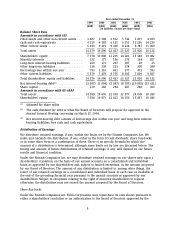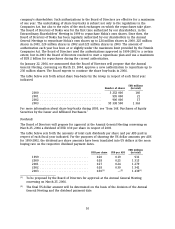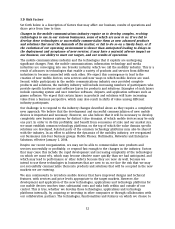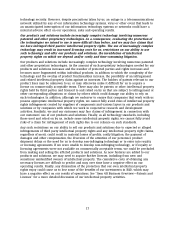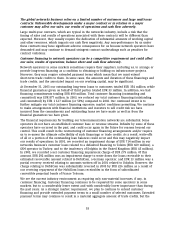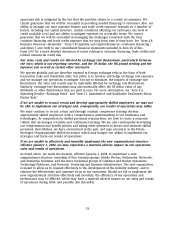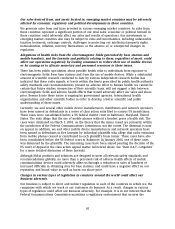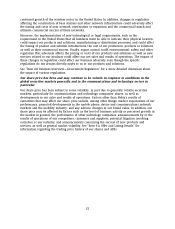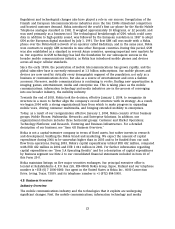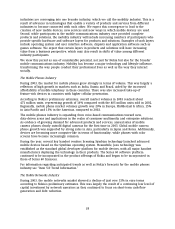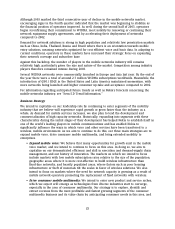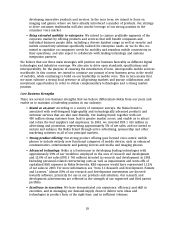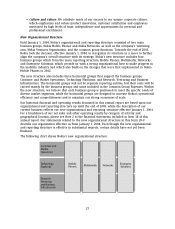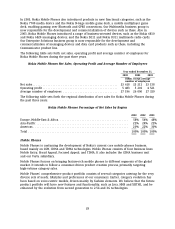Nokia 2003 Annual Report Download - page 20
Download and view the complete annual report
Please find page 20 of the 2003 Nokia annual report below. You can navigate through the pages in the report by either clicking on the pages listed below, or by using the keyword search tool below to find specific information within the annual report.associated risk is mitigated by the fact that the portfolio relates to a variety of customers. We
cannot guarantee that we will be successful in providing needed financing to customers. Also, our
ability to manage our total customer finance and trade credit exposure depends on a number of
factors, including our capital structure, market conditions affecting our customers, the level of
credit available to us and our ability to mitigate exposure on acceptable terms. We cannot
guarantee that we will be successful in managing the challenges connected with the total
customer financing and trade credit exposure that we may from time to time have. See ‘‘Item 4.B
Business Overview—Networks,’’ ‘‘Item 5.B Liquidity and Capital Resources—Customer Financing,’’
and Notes 7 and 34(b) to our consolidated financial statements included in Item 18 of this
Form 20-F for a more detailed discussion of issues relating to customer financing, trade credits and
related commercial credit risk.
Our sales, costs and results are affected by exchange rate fluctuations, particularly between
the euro, which is our reporting currency, and the US dollar, the UK pound sterling and the
Japanese yen as well as certain other currencies.
We operate globally and are therefore exposed to foreign exchange risks in the form of both
transaction risks and translation risks. Our policy is to monitor and hedge exchange rate exposure,
and we manage our operations to mitigate, but not to eliminate, the impacts of exchange rate
fluctuations. Our sales and results may be materially affected by exchange rate fluctuations.
Similarly, exchange rate fluctuations may also materially affect the US dollar value of any
dividends or other distributions that are paid in euro. For more information, see ‘‘Item 5.A
Operating Results—Exchange Rates’’ and ‘‘Item 11. Quantitative and Qualitative Disclosures About
Market Risk.’’
If we are unable to recruit, retain and develop appropriately skilled employees, we may not
be able to implement our strategies and, consequently, our results of operations may suffer.
We must continue to recruit, retain and through constant competence training develop
appropriately skilled employees with a comprehensive understanding of our businesses and
technologies. As competition for skilled personnel remains keen, we seek to create a corporate
culture that encourages creativity and continuous learning. We are also continuously developing
our compensation and benefit policies and taking other measures to attract and motivate skilled
personnel. Nevertheless, we have encountered in the past, and may encounter in the future,
shortages of appropriately skilled personnel, which may hamper our ability to implement our
strategies and harm our results of operations.
If we are unable to effectively and smoothly implement the new organizational structure
effective January 1, 2004, we may experience a material adverse impact on our operations,
sales and results of operations.
As noted above, we made the decision, effective January 1, 2004, to implement a new
organizational structure consisting of four business groups, Mobile Phones; Multimedia; Networks;
and Enterprise Solutions, and the three horizontal groups of Customer and Market Operations;
Technology Platforms; and Research, Venturing and Business Infrastructure. The new organization
is meant to allow us to respond effectively to the development of the mobility industry, and to
enhance the effectiveness and customer focus in our operations. Should we fail to implement the
new organizational structure effectively and smoothly, the efficiency of our operations and
performance may be affected, which may have a material adverse impact on our sales and results
of operations during 2004, and possibly also thereafter.
19


